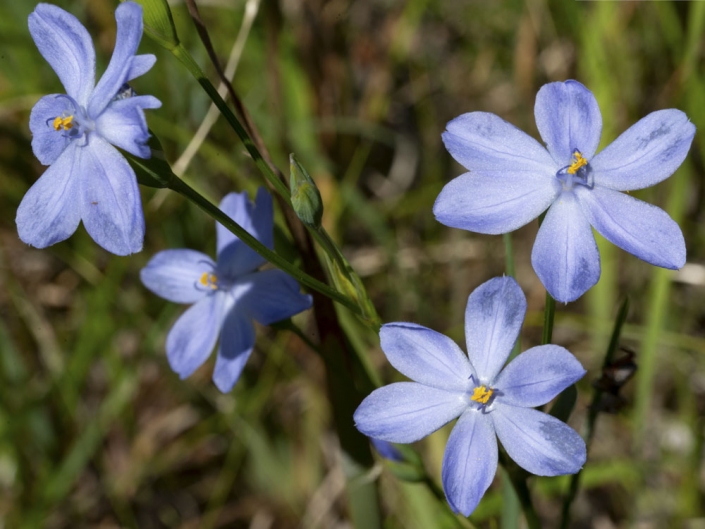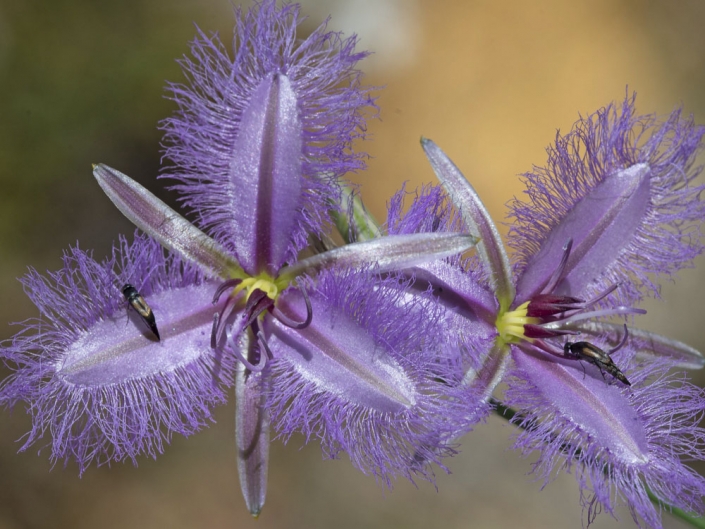Point of Interest 16: Banksia Woodland
This area has open banksia jarrah woodland to the north which transitions into dense forest. A narrow strip of partly disturbed vegetation with more weeds is adjacent to the school fence to the south. Kangaroo Paws are abundant at the start of a sand track which reconnects to the Jarrah Trail 150 m north at POI 9. Nursery-grown local species were planted south of the trail in 2023. An interpretive sign about local orchids is found nearby. Numerous Kangaroo Paws flower near the narrow side track between POI 15 and 16 in early spring.
Common Wildflowers
Autumn – Grass Wattle (Acacia willdenowiana)
Winter – Yellow Banjine (Pimelea sulphurea), Three-flowered Daviesia (Daviesia triflora), Milkmaids (Burchardia congesta)
Spring – Kangaroo Paws, Blueboy
Late Spring& Early Summer – Purple Flag, Snottygobble (Persoonia saccata), Eremaea pauciflora, Jarrah
Focus Topic 33. The Friends Group and Bushcare Activities
The Friends of Warwick Bushland is a community group that cares for this area. The Group was established in 1999 by Karen Clarke and Robyn McElroy and built on Robyn’s group that formed two years earlier to care for the high school bushland. The Friends of Warwick Bushland undertake activities such as biological surveys, collecting seeds, planting in degraded areas, weeding, removal of rubbish, guided walks, displays and talks. The group has accumulated a large amount of historical and scientific knowledge about the site’s past use and its vegetation, flora, fauna and fungi. Membership is free and open to all ages. For more information visit our website or email friendsofwarwick@gmail.com.
After a protective firebreak was formed between Warwick Senior High School and the Bushland, the trunks and branches were used to close old tracks and create habitat for insects and reptiles which in turn are a food source for the many bird species found in the Bushland. Many Fungi species can also be found in this area. Most of these break down wood to recycle nutrients back into the ecosystem or form essential symbiotic associations with plants (Focus Topic 36).
Friends of Warwick Bushland (interview)
Focus Topic 34. Native Irises and Fringe Lilies
The iris family (Iridaceae) includes two beautiful local species that flower prolifically in spring. The Morning Iris (Orthrosanthus laxus var. laxus) flowers in mid spring, while Purple Flag (Patersonia occidentalis) flowers in late spring. Both are primarily pollinated by native bees but also visited by beetles and moths. They both have very short-lived flowers that open in the morning, close in the middle of the afternoon and never open again. Our irises compensate for this by producing new flowers every day over several weeks. Morning Iris flowers are also unusual because blue flowers are uncommon globally.
Our beautiful Fringe lilies (Thysanotus species) also have flowers that only last one day and have very intricate filaments on petal margins. There are five species of fringe lilies in Warwick Bushland that flower at different times from spring to mid-summer. The most common are Thysanotus manglesianus, a climbing plant with small flowers and Thysanotus sparteus, a tall and extremely hardy species producing large flowers in early summer from branched wispy stems that lack leaves. Most fringe lilies have buzz-pollinated flowers (Focus Topic 6).


















